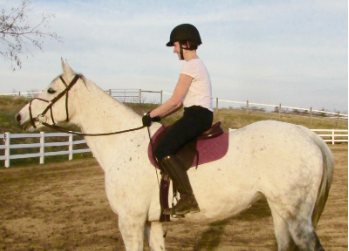Riders communicate to the horse via three aids, the seat (pelvis and buttocks) the legs and the hands! The rider’s seat should envelop the horse’s back like an upside down U and allow the horse to move through the seat. A rider’s neutral seat learns to go with the movements of the horses and allows the horse to go forward by not interfering, and a more advanced seat will influence the horse’s gaits. The whole position of the rider is often referred to as the “the seat”. There is no doubt that a rider with a good seat whether basic or advance will be a complimentary rider!
If the seat is not balanced and does not go with the horse’s motion, if it leans or is not positioned correctly, the rest of the rider’s aids are compromised. A good seat is in balance: it does not fall off to one side. If the rider’s spine is aligned with the horse’s spine, then the seat is in balance. The best way to learn how to keep a seat balanced is to ride bareback.* Another way is to ride straight lines with the horse off the railing of the arena. A rider cannot put the horse straight if they are not sitting straight with a balanced seat!
Learning how to ride requires the rider to keep a balanced seat while using the other aids (legs and arms) to influence the horse. If a rider uses an opening rein she often leans and the seat loses balance. Or when a rider uses a leg aid and the muscles tighten and shorten this also causes the seat to become compromised. Having an independent neutral seat means the other body parts of the rider are not being adversely affected when the other aids are used. Independent use of the aids are paramount for good riding.
A rider’s seat in addition to being balanced and not being compromised when the other aids are used is only correctly positioned if the rider is sitting on the seat bones! Many riders sit on the coccyx instead of the seat bones, and this rounds the rider’s back. This is called “pocket sitting” because the rider is sitting on the pockets of their pants! For the correct seat position, the rider should be sitting upright on the two sitting bones. Sitting on the two seat bones allows the rider’s spine to utilize the two natural curves of the back in the lumbar and neck. The pelvis should neither be tucked under ( pocket sitting ) or rotated forward, also called perching. Pocket sitters remove the natural curve of the lumbar area and this affects how the leg aids are used, and the rider wonders why the horse does not understand their signals! And the rider who over arches the lower back by perching causes the stiffening of the pelvis and will inhibit the rider’s seat from going with the horse’s motion and the other aids to be used fluently!
Once the rider has the pelvis (seat) correctly sitting on the horse in a neutral position not arched forward or rounded under, then she needs to be sure the head is balanced! The head is also part of the rider’s seat because it is connected to the seat via the spine. If the head is not balanced on top of the spine the seat will be compromised, and the rider’s arm connection to the bit will be affected. Everything is connected! Leaning the head to one side causes the torso and or seat to lean, poking the head forward stiffens the spine, putting the chin down will round the spine, or putting the chin too high will tense the neck, shoulders, spine and pelvis of the rider.
The rider seat is to be in neutral balance with the rider sitting on the sitting bones. A neutral pelvis means the rider is not perched or hollow in the lower back, or tucked under as in a “pocket sitter.” The seat is also to be balanced: equally distributed on both sides of the saddle. Once a proper seat position is developed, and the rider can maintain a good position on the horse without tensing, then the rider learns how to apply the aids without interfering with the seat’s balance. All riding aids: the legs, seat and hands need to be able to communicate to the horse without tensing or losing their relative “position.” Good riding is no doubt a skill and just like the famous saying, “no hoof, no horse,” I think every rider would agree “no seat, no rider!”
* (See Pittsburgh Pet Connections article: http://issuu.com/pghpetmag/docs/petconnections_may14_web/35?e=6029391/7749457.)



